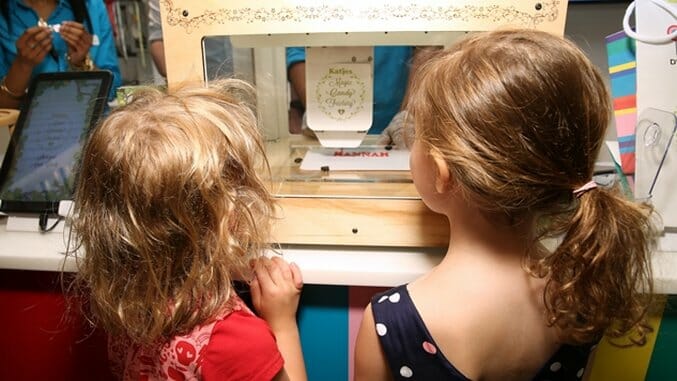3D Printers: Fostering a Connection Between Business and Education
Photo by Cindy Ord/Getty Business Features 3D Printers
In need of a replacement bone, prosthetic ear, or a part for your car? Hungry for a slice of pizza How about a pair of custom designed shoes to support your feet while playing your newly designed guitar
These objects, while vastly different in form and function, all have one thing in common: they can be “printed” using a 3D printer.
What is 3D printing?
3D printing or additive manufacturing is a process of making three-dimensional solid objects from a digital file. The creation of a 3D printed object is achieved using additive processes. In an additive process, an object is created by laying down successive layers of material until completed. Each of these layers can be seen as a thinly sliced horizontal cross-section of the eventual object.
This process has been around for years, but it’s only recently that smaller businesses, schools, and even your average hobbyist have been able to watch their idea come to life with the touch of a button.
3D printing cuts out the middleman in business
When it comes to 3D printing, a business can find limitless uses for this technology. “One of the benefits of a 3D printer is the ability to cut down the engineering process by a considerable amount,” says Matthew Jones, Lead Mechanical Engineer at Art Morrison Inc.
“Before our use of 3D printers, we had to wait for our machine shop to have a break in production (if there was any) and wait for materials to be delivered. Now, we can just model the part and have it in our hands the next day,” he adds.
And then there’s the ability to create a more “user-friendly” relationship with the customer through design validation. “When a business needs a part machined/made, a 3D printed design can be given to the customer to check for proper fit or appearance in a matter of hours instead of days or weeks,” Jones explains.
Connecting schools to businesses with 3D printers
The evolution of 3D printers has been observed not only in businesses but also in the educational setting, as schools are discovering that just about every subject could benefit from 3D printing technology.
Those schools are looking to Career and Technical Education (CTE) programs to lead the way with 3D printing. “CTE can be a lighthouse for students looking to try out a career, learn a trade, or have an outlet from other classes they may be struggling in,” says Brandon Brown, an Engineering and Animation teacher at Olympic High School in Washington state.
“These programs assist in driving home the importance of taking your education seriously as sometimes it’s hard to see the forest through the trees when you’re a teenager,” he adds.
Providing opportunities for teenagers to “see the forest through the trees” is exactly the result educators strive for every day.
Fostering curiosity and getting kids excited about their education is the reason Brown decided to go into teaching in the first place. His enthusiasm is reflected in the hundreds of students flocking to his classroom each year. “When starting a new school year, I usually have the 3D printer printing as students are coming into the classroom for the first time,” says Brown.
“First, they’re curious about what’s making all that noise. Then [the students] see the machine. And the most amazing part is their expressions as they watch the printer lay down the printing layers. They are so blown away by the process, which automatically leads them to ask one question: when do we get to print something?”
A question that always seems to excite Brown just as much as his students.
The way students are interacting with 3D printing is showing them the ways technology itself opens the doors to endless possibilities. These printers could very possibly be the future for manufacturing, science, and engineering.
But first, CAD processes and design must be understood to utilize all of the functions of a 3D printer fully. “Having classes that teach students how to digitally design parts that solve a need or bring their 3D animation characters to the real world, is the more important part of 3D printing,” says Brown.
As students learn how to design and print materials, they are leading the way in turning their ideas into viable products. “Students can physically see, touch and feel creations that were previously only in their mind,” explains Brown. “And this is extremely powerful when getting kids interested in computer based design.”
And just like Brown, Jones also feels strongly about the need for students to connect what they learn in school to the world of work. “Kids need to know what it’s like to build something of their design and 3D printers allow them to do that in a modern way,” says Jones.
“The skills they use along the path for a successful 3D print will help them for years to come, and help our country be a leader in the extremely competitive world of high-tech manufacturing,” he adds.
Looking forward into a 3D printed future
As is the case with most technology, we have no idea what will transpire in the next day, month or year.
In fact, Brown says he can envision a day coming soon where 3D printers could be in most homes. “A 3D printer could be an appliance just like all of your other traditional ones,” he explains. “Need a part to fix your dishwasher, your drone, your car? Go to the manufacturer’s website and find the part and click print,” he says with enthusiasm.
“No waiting for shipping or having to call the local store,” says Brown. “And jobs will continue to evolve as our world becomes more digital. New jobs we’ve never even thought of, will undoubtedly pop up to fill that gap. Quick! Johnny, call the 3D printer repairman!”